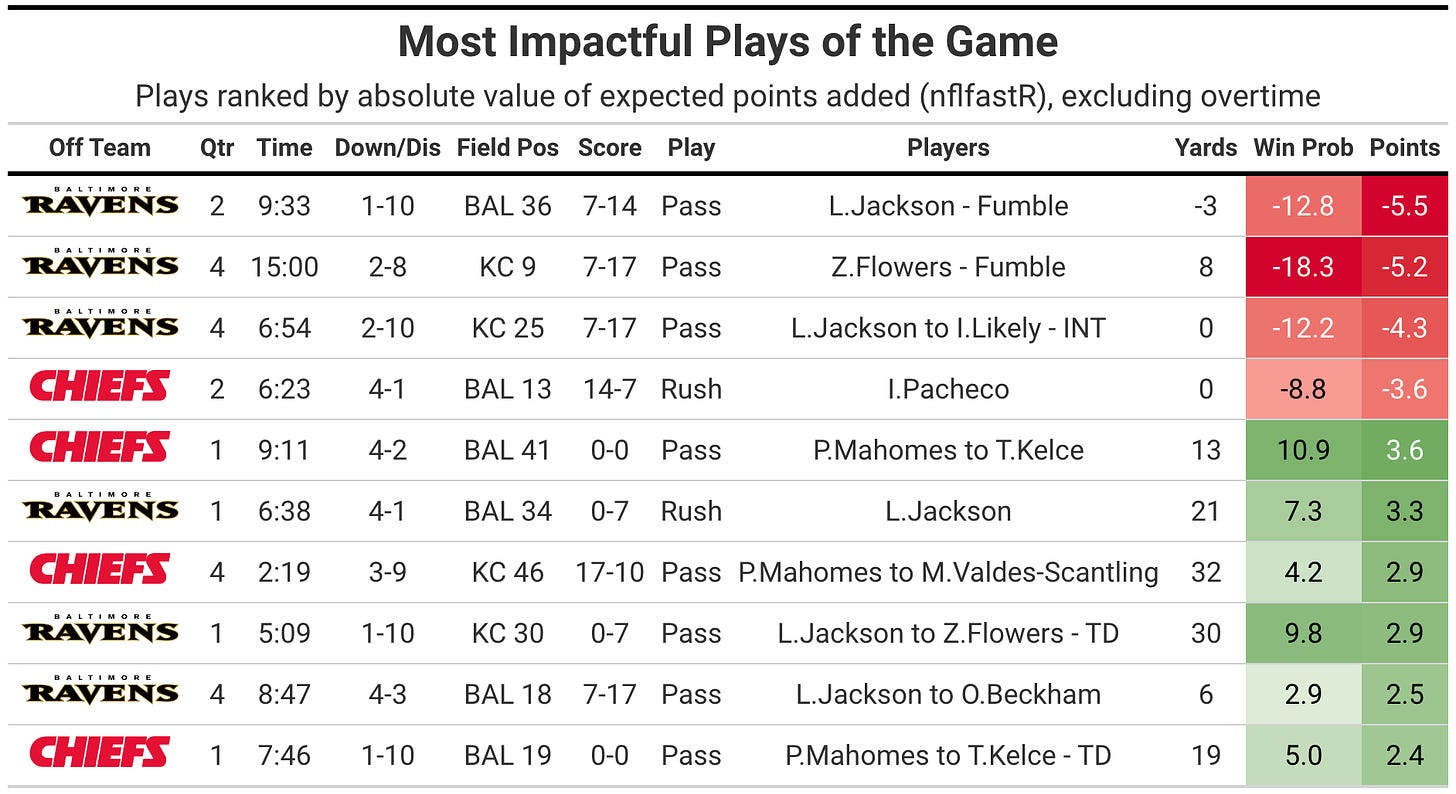Conference Championship, Ravens-Chiefs & 49ers-Lions: Advanced Reviews
The Chiefs and 49ers set up a Super Bowl rematch, with increased levels of strength for the Chiefs defense and 49ers offense
The adjusted scores quantify team play quality, with emphasis on stable metrics (success rate) and downplaying higher variance events (turnovers, special team, penalties, fumble luck, etc). Adjusted expected points added (EPA), in conjunction with opportunity-based metrics like total plays and drives, projects adjusted points. Adjusted scores have been tested against actual scores and offer slightly better predictive ability, though their primary benefit is explanatory.
All 2023 & 2022 and historical Adjusted Scores and other site metrics are available in a downloadable format to paid subscribers via Google Sheet.
Find previous advanced reviews here
** Adjusted Scores table:
“Pass” - Pass rate over expectation (based on context of each play and historical averages
“Success” - Success rate on offense, a key metric in adjusted score vs actual
“H & A” - Home or away team
BAL-KC
Before running the numbers, I thought the adjusted scores might have this even closer than the 3-point differential given, mainly reflecting the Ravens gaining a yard-and-a-half more per play than the Chiefs (5.9 to 4.4), and the game being decided completely by higher variance turnovers and third-down conversions. The Ravens lost 15 expected points on their interception and two fumbles, and they only converted 3-of-11 third downs, a rate 22% below expectations, after converting at a rate over expectation during the rest of the season.
However, the Ravens’ offensive efficiency (excluding turnovers) was primarily driven by a handful of big plays, which are also discounted in the adjusted-scores model. While the Ravens offensive success rate was only 40%, which was 5% lower than the Chiefs. The Ravens passing production was particularly chunky, only completing 20-of-37 passes, gaining 123 of their total 272 passing yards on three plays of 30-plus yards. Even the Ravens running success (90th percentile EPA efficiency, 5.1 YPC) was built on an unimpressive 40% success rate.
You could make the argument that the adjusted scores undervalue the offensive game of the Chiefs, being that they relied more heavily on the run while playing with a multi-score lead for most of the game, and weren’t good at all when handing off the ball. The Chiefs dropped back to pass at a 68% rate in the first half, which lowered to under 60% in the second half, with the halves’ dropbacks falling from 32 to 18, while designed runs went from only 15 to 12.
The Chiefs passing efficiency went from excellent to poor by half (+0.41 EPA per play to -0.17), but their rushing efficiency was equally bad in both halves. In the first half the Chiefs had poor rushing efficiency mostly due to a failed 4th & 1 conversion attempt on the Ravens 13 yard-line (-3.6 EPA), whereas in the second they simply couldn’t do anything positive, losing EPA on all but two attempts.
It was a frustrating watch for pass-supremacists seeing the Chiefs playing the second half as if they didn’t think the Ravens could make up a 10-point deficit, even if Andy Reid was proven right. For me, I think this was a massive mistake, and could have cost them the game if a couple turnovers didn’t go their way. Luckily for the Chiefs they only need Patrick Mahomes and Travis Kelce utilized to full capacity for one half in order to score enough points to win.
Mahomes didn’t produce outstanding efficiency on his 50 dropbacks and designed runs, but +0.20 EPA per play was plenty strong. The Chiefs offense was methodical moving down the field on their early drives, and Mahomes finished with a +13.6% completion rate over expected, his second-best result, only trailing last week’s +18.2% against the Bills.
There’s not much more you can say about the greatness of Mahomes at this point. Even if there is a bit of luck in the timing of how he stepped up his play this season, you can’t write off the significance of Mahomes having his best games when the lights are brightest. His EPA per play has jumped to +0.35 in this postseason from a “down” regular season of +0.13. It’s not hyperbole to say he’s easily on the path to being the greatest of all time.
Keep reading with a 7-day free trial
Subscribe to Unexpected Points to keep reading this post and get 7 days of free access to the full post archives.








